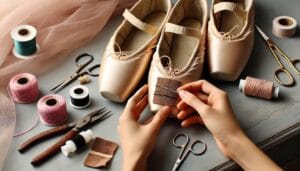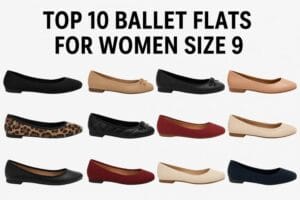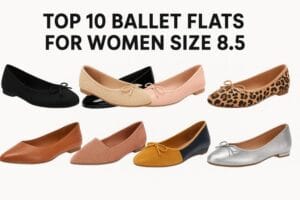Are Supportive Insoles Enough to Make Ballet Flats Healthy: A Complete Guide
- Published on -
- By - Sophia Webster
- Reviewed by - Tory Burch
- Reading Time - 9 Minutes

Share this Post
Recent Posts
About Author
Sophia Webster
The aesthetic design may lead to the problem of insufficient cushioning and limited arch support, turning these flats into a hazard for foot health, especially when worn for extended periods. This paper delves further into the biomechanics of the foot, the challenges presented by ballet flats, and how some of these issues can be addressed through the use of supportive insoles.

1. Understanding the Limitations of Ballet Flats

1.1 Inadequate Arch Support
Role Of The Arch: An arch on the foot assists in weight distribution and absorbs shock. Shoes that do not support the arch such as a typical ballet flat overuse and place undue strain on the fibrous tissue band that runs along the underside of the foot known as plantar fascia.
Possibility Of Plantar Fasciitis: Without adequate support, the plantar fascia can become inflamed and painful, usually along the heel area, which is often referred to as plantar fasciitis.
1.2 Minimal Cushioning
Limited Shock Absorption: Ballet flats traditionally feature very thin soles which do not provide a lot of shock absorption to stress the foot. Repeated impact over long periods can put stress on the knees, hips, and lower back.
Effects on the Joints: Without any kind of shock absorption padding, this condition might further worsen the issues with the joints or create new ones due to the ceaseless impact against rigid surfaces.
1.3 Flat Sole and Stability
Ankle Injury and Instability: A completely flat sole may add to the ankle instability factor increasing the chances of spraining or twisting the ankle.
Over Pronation: The absence of adequate support can cause rolling one’s foot too far inward, which may lead to misalignment of the ankle, knee, and hip joints.
1.4 Tight Toe Box
Toe Box Surgery: Most ballet flats come with sloping toe boxes thus restricting toes from going beyond a particular range. This may encourage the development of bunions, hammertoes, or other deformities in due course.
Splay Importance: Toes play an important role when it comes to helping a person maintain balance. Restricting movement in the toes greatly impairs their health.
1.5 Material Limitations
Situations of Subjects Using Words Masked Under: Some materials used in making ballet flats like synthetic ones do not allow the foot to breathe. This situation can cause an accumulation of excessive moisture, which in turn may lead to blisters or may cause infections but fungi.
Comfort vs. Durability: Items constructed out of cheaper materials may result in insufficient support and cushioning whilst also wearing out quickly.
A Closer Look at Biomechanics

Foot Anatomy and Function
Arches, Bones, Ligaments: The foot is made up of 33 joints, 26 bones, and so many ligaments, it is designed to take the shock of absorbing and distributing the entire weight of the body.
Proprioception: The sensory receptors located in the foot account for the movement and position of the body and guarantee an explanation as to where the body is at any given point in time. A shoe that has no adequate structure will mask the position of the ground resulting in disruption of balance which is dangerous.
Gait Analysis
Stride Length and Foot Strike: The wearing of ballet flats seems to restrict step amplitude besides stride length which is thought to be caused by lack of cushioning. This may increase strain on the forefoot or the heel region of the foot.
Weight Transfer: If the support is removed, it causes shifting of weight onto the foot’s area that is not designed to withstand repeated blunt trauma, leading to damage of the soft tissues and resulting in overuse injuries.
Research Insights: Some studies seem to suggest that there is an increase in the force applied to the tendons compared to other skeletal structures at the rear and anterior part of the foot (ballet flats), with greater focus on the forefoot which contributes to shifting one’s gait pattern.
Effects on the Kinetic Chain
Alignment Relations Involving the Ankle, Knee, Hip, and Spine: The malignment of the foot can result in a spiral chain reaction all the way to the posture and gait.
Compensatory Movement: Adaptation will occur in the form of shuffling at the knee or hip, which may lead to inadequate foot support and possible lumbago or knee strain.
2. The Role of Supportive Insoles

2.1 Categories of Insoles
Medial Arch Support Insoles: Designed to support the foot’s medial arch, they reduce strain on the plantar fascia.
Cushioning Insoles: Made of foam or gel, they lessen joint stress and enhance cushioning of the foot.
Orthotic Insoles: These are custom-made for specific foot conditions, providing corrective treatment for overpronation or supination.
2.2 Advantages of Insoles
Arch Support: Assists in redistributing the biomechanical load, hence, improving foot stabilization.
Cushioning: Enhances shock absorption and reduces stress on the joints.
Improved Fit: Occupies the excess volume of a shoe, preventing foot part movement and resultant friction injury.
2.3 Limitations About Insoles
Issues with a Narrow Toe Box: Once again, the insole cannot expand the toe of the shoe. If the toe box is already a closed one, it is impossible to cure with an insole.
More Advanced Foot Conditions: Individuals with more advanced foot diseases may, some of the time, require some professional assistance or need to be fitted with custom-made orthotic devices.
Fit Changes: Insoles will take up space. Therefore, they may cause the shoe to fit too snugly. They may also alter the way the shoe fits in a way that is unpleasant.
No Side Support for the Outer Sole: The bottom part of the shoe could receive no modifications other than what is done to the insole, adding some traction along with thickness, and wrinkles on the sole.
3. Single Result Concerning Detailed Insole Research
3.1 Material Science
Foam and Gel: Provide cushioning but may compress over prolonged periods.
Cork: Often found in orthotic inserts, it provides light support while effectively absorbing shocks.
Stiff Orthotic Materials: Also, custom orthotic aids such as plastics and carbon fiber are useful for individuals with advanced conditions that need corrective support because they require strong structural correction.
3.2 Custom Made Vs. Off-The-Shelf
Off-the-shelf custom orthotics are very precise foot disorders designed for individuals who have been diagnosed with advanced foot disorders and are tailored to an individual’s gait.
3.3 The Insole Position And Fit The proper position
The upper or arch support part of the arch in the insole must be positioned properly at the arch where it was marked to be placed.
To prevent slippage: an insole that is not properly aligned can cause friction and subsequent blistering.
Medical and Podiatric Perspectives
Expert Interviews
Podiatrists & Orthopedic Surgeons: A common complaint patients suffering from chronic foot pain have is that their footwear is often not supportive. Ballet flats in particular seem to exacerbate their foot pain.
Physiotherapists: The correct type of footwear and strengthening the muscular system of the foot is important to prevent injury.
Medical Studies and Research
Plantar Fasciitis Prevalence: There appears to be some evidence to suggest that lack of supportive arches is a prevalent complaint of this condition.
Bunion Development: Research seems to link narrow toe boxes to a greater occurrence of bunions among people who wear constricting footwear most of the time.
Pathophysiology
Chronic static load: Chronic loading of unsupported areas of the foot may, with time, lead to tissue injury of connective tissue structures like ligaments, resulting in tendinopathy, and arthritis of joints.
4. Alternatives and Recommendations for supportive insoles that make ballet flats healthy
If you find ballet flats uncomfortable or causing foot problems, these strategies and recommendations may help:
4.1 Ballet Flat Alternatives
Sneakers, loafers, and oxfords tend to have more arch support, a stiffer sole, and more space in the toe box compared to other shoes.
Features to look for: Maintaining the foot’s structure and extending support to the arch area, as well as a cushioned inner sole and wider forefoot.
4.2 When to use ballet flats
Light Activities, Short Periods: Walking any significant distance in flats entails minimal risks compared to other activities.
Balance is Important: Avoid long periods of sitting or standing still, brisk walking, or any other high-impact activity.
4.3 Professional Consultation
Custom Orthotics: Consider orthotic devices prescribed by a podiatrist if you experience ongoing pain or have foot structure issues.
Cobbler Modifications: Some cobblers may apply outer soles or partial supportive inserts that aid the instability of ballet flats.
5. Practical Applications and Recommendations for supportive insoles that make ballet flats healthy
1. Foot exercises and stretches
Toe Spreads: Enhancing flexibility by spreading toes is a form of exercise.
Calf Stretch: Stretching the Achilles tendon that is unsupported.
Arch Strengthen: Strengthening foot muscles by picking marbles with the toes.
2. Shoe modification techniques
Externally Adding Soles: A supported alternation to add thick soles on flats done by cobblers.
Partial Orthotic Inserts: Some shoe repair shops offer the service of placing partial orthotic pieces under the insole which can be helpful.
3. Lifestyle Changes
- Occupation: Those whose work involves prolonged standing and walking need to invest in supportive footwear.
- Hobbies: Participation in high-impact sports or regular walking may necessitate the possession of some athletic shoes other than the usual flats.
Case Study:
The most holistic approach to achieving long-term goals was reached through a combination of foot exercises, strategically selected footwear, and insoles.
FAQs
Research Question 1: To What Degree Can Insoles Help Ballet Flats Be More Foot-Friendly?
Adding support and comfort through insoles has shown effectiveness, but also does not eliminate the multiple drawbacks posed by the design of ballet flats.
The design of ballet flats brings issues such as the lack of an arch, heel, and cushioning, as well as having a flat sole.
However, these shoes can be made significantly more comfortable by adding necessary support and cushioning through insoles.
It is unwise to wear the shoes without added cushioning for extended periods of time.
Research Question 2: What Type of Insoles Work Best with Ballets Flats?
The toes must not be constricted; therefore, quarter-length arch supports should suffice.
The insole is empowered with arch support and cushioning on the ball and heel.
Select gel or memory foam insoles for better shock absorption.
They are designed for flats or low-profile shoes.
Research Question 3: Is it possible to reduce the pain caused by ballet flats using insoles?
The shoes may feel tighter if they are already snug-fitting.
Severe unresolved foot deformities may persist, especially with serious medical foot conditions.
Some insoles tend to shift when put inside the shoe, so they may slide around.
Research Question 4: Do ballet flats come with any disadvantages when used with insoles?
Yes, ballet flats often lead to foot discomfort, but insoles can help ease and prevent issues like:
- Pain in the ball of the foot.
- Pain in the heel.
- Pain in the arch.
They make it easier to walk by providing added support, which helps reduce strain on the feet.
It is recommended to see a Podiatrist if you have existing foot issues.
Research Question 5: Is there any situation I should avoid wearing ballet flats even with insoles?
Do not wear them if you will be standing or walking for an extended period.
Avoid using them in high-impact activities.
If you have ongoing foot pain, it is advised to stop using them and see a podiatrist.
For individuals suffering from foot conditions such as plantar fasciitis or profound flat feet, wearing ballet flats is typically a poor choice of footwear.
Conclusion:
As easy as it is to put on and take off, the lack of sufficient cushioning, arch support, and toe box flexibility makes wearing ballet flats a challenge. While it is clear that the footwear has simplistic yet eye-catching designs, worrying about the biomechanics of the foot brings into focus disrupted gait cycles. The gradual misalignment along with debilitating pain. Though the insoles placed in the shoes help cushion the heel and arch, there is no support in the structure of the shoe itself.
As has been the case previously, the decision to wear ballet flats should be based on personal factors such as individual foot anatomy, activity level, and other comorbidities. For those wishing to keep the aesthetic of ballet flats, moderation is imperative. Lowering the time spent wearing them, pedal devices such as orthotics, and advice from podiatrists and chiropodists can all mitigate the risk. For individuals whose forefeet will be stationed for an extended period of time within ballet flats, it is advisable to use shoes with more moderate support and wider toe boxes, or customized changes to the footwear may be required.






